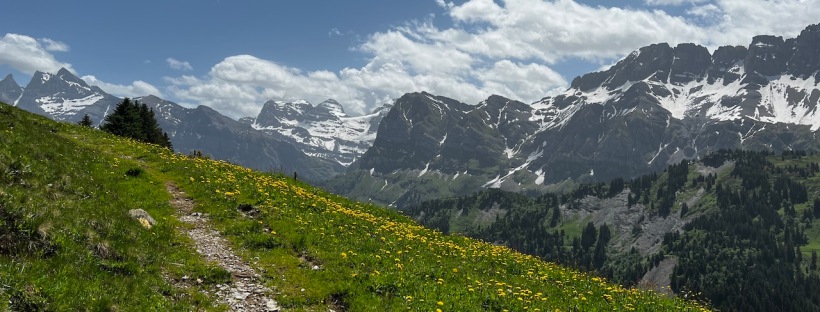
I spent today at rest, my tired body embraced by the stirrings of a deeply embodied cognition of mountains, muscles, and memory from the past few days, dozens of kilometres and thousands of metres of ascent. As a mountain runner of some decades now, my legs have steadily become a topography of the ranges I’ve run across, and I feel the memory of those mountains with every new run.
I completed my first long-distance day in 1989 across 54 miles of the White Mountain range in northern New Hampshire. That same year as a sophomore in college, I was introduced to Dante’s Divine Comedy, through which Dante follows first alongside Virgil and then Beatrice — always on foot — from ‘quasi al cominciar de l’erta‘ to his eventual seat before ‘l’amor che move il sole e l’altre stelle‘.
When, this past week I also found myself ‘al piè d’un colle giunto, là dove terminava quella valle’ in the Alps south of Lac Léman, it was the mountains as much as my own body that drew me ever upward, the topography of my thighs and calves limned by an inner landscape responding to a latent rhythm that had recently grown too still. Even within that stillness, the mountains that drew me both upward and inward through forest and meadow and snowfield and scree — dans l’étreinte des montagnes.

Thomas Nail in his brilliant and creative reading of De Rerum Natura shows us that ‘action through matter is at the foundation of Lucretius’ ethics of motion’ and that Lucretius, ‘in this poetic state, thus becomes the movement of desire immanent to both.’ If Lucretius, affirming through an insistent dactylic hexameter —
quam variis distantia formis
sponte sua volitent aeterno percita motu (!!)
— it isn’t too far a scramble from the foundations of this first-century BC re-reading of Epicurus to Nail’s insistence that the poet becomes the movement as action is the performativity of matter. It isn’t much farther, perhaps through Matthew Tiessen’s following a mountain-bike trail to its logical conclusion — that “Humans can be thought of not as individuals . . . but as articulations and expressions of their environments. Each of us is a site-in-process, a crossing, where forces come to play.” And, finally, to build on Tim Ingold’s invitation to consider that “If perception is thus a function of movement, then what we perceive must, at least in part, depend on how we move. Locomotion, not cognition, must be the starting point for the study of perceptual activity.”
When Thomas Nail draws in Virginia Woolf, who writes in Waves, “There is nothing staid, nothing settled, in this universe. All is rippling, all is dancing; all is quickness and triumph,” he may not be writing explicitly about mountains, endurance or running at all, yet this complexity of text and place and sensual topography practically vibrates with the possibility of emphatic movement across centuries, languages bodies and place.
Still more — there has been some recent research on the physiology of ‘muscle memory’ that suggests myonuclei can retain the memory of their hypertrophic states for 15 years or more. This means in practice that muscles trained through action, even if they are left to atrophy through disuse, can recover their previous state with less effort by remembering previous activity — up to nearly two decades later! This research, confirming what I would call a kind of embodied cognition, is nothing less than revolutionary — that a landscape can find its way into the nuclei of our muscles and remember the undulations, steep climbs and precipitous descents of a mountain so that we become maps of the landscape —
or, better still,
— we become the mountain and the mountain becomes, inextricably, us.

